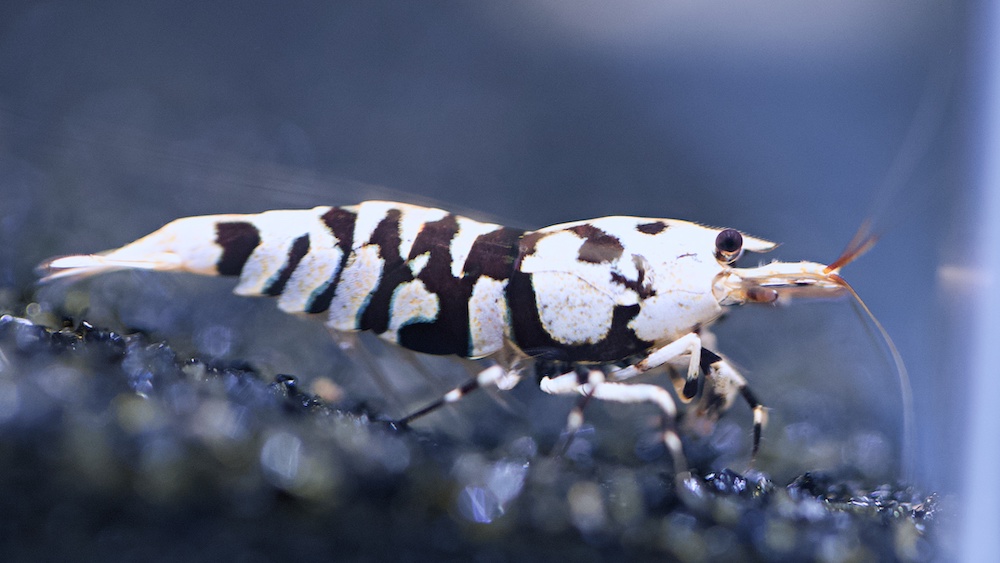Brief Description of Fancy Tiger Shrimp Appearance: Fancy tiger shrimp, a mesmerizing hybrid breed, exhibit a striking pattern characterized by vivid stripes and patches on their bodies. Their distinct coloration ranges from vibrant reds and oranges to deep blacks and whites, creating a captivating contrast.
Scientific Name and Classification: Fancy tiger shrimp belong to the species Caridina cf. cantonensis. They are part of the Caridina genus within the Atyidae family, commonly known as dwarf shrimp.
Origin and Natural Habitat: These shrimp originate from selective breeding efforts in captivity, primarily in Asia. Their ancestors, the wild forms, hail from the freshwater streams and rivers of Southeast Asia, where they thrive in stable, well-oxygenated environments.
Physical Appearance, Size, and Lifespan: Fancy tiger shrimp typically grow to around 1.5 inches (3.8 cm) in length, showcasing a slender body adorned with intricate patterns. Their lifespan averages between 1.5 to 2 years under optimal conditions in aquarium settings.
History of Fancy Tiger Shrimp
Development through Selective Breeding: Fancy tiger shrimp emerged as a result of meticulous selective breeding aimed at enhancing their unique color patterns. Breeders selectively crossed Crystal Red Shrimp (Caridina cantonensis var. “Crystal Red”) with Tiger Shrimp (Caridina cf. serrata), achieving the distinctive striped and spotted appearance seen in fancy tigers today.
Relation to Crystal Red Shrimp: Crystal Red Shrimp played a pivotal role in the development of fancy tigers due to their genetic contribution to the hybridization process. Traits from Crystal Red Shrimp influenced the coloration and markings of the fancy tiger, creating a visually appealing shrimp for enthusiasts.
Popularity in the Aquarium Hobby: Since their introduction, fancy tiger shrimp have gained significant popularity among aquarium hobbyists worldwide. Their eye-catching appearance, coupled with relatively manageable care requirements, has positioned them as sought-after additions to planted aquarium setups.
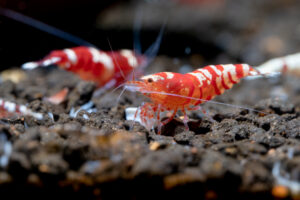
Fancy Tiger Shrimp Care and Ideal Water Parameters
- TDS (Total Dissolved Solids): 100-120 ppm
- pH: 5.4-6.2
- GH (General Hardness): 4-5 dGH
- KH (Carbonate Hardness): 0-1 dKH
- Temperature: 60-72°F (15.5-22°C)
Setting Up a Successful Fancy Tiger Shrimp Tank
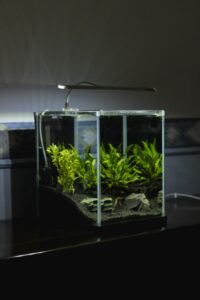 Tank Size Recommendations: For a thriving colony of fancy tiger shrimp, a tank size of at least 5 gallons (19 liters) is recommended. Larger tanks (10 gallons or more) provide more stable water parameters and space for the shrimp to explore.
Tank Size Recommendations: For a thriving colony of fancy tiger shrimp, a tank size of at least 5 gallons (19 liters) is recommended. Larger tanks (10 gallons or more) provide more stable water parameters and space for the shrimp to explore.
Filtration Options (Focus on Sponge Filters): Sponge filters are highly recommended for fancy tiger shrimp tanks due to their gentle water flow and the fact that they don’t suck up baby shrimp. They also provide a surface for beneficial bacteria, which aids in biological filtration.
Substrate Choices: Use a fine-grained substrate like ADA Amazonia or fine gravel to maintain stable water parameters. This substrate helps buffer pH and provides a surface for beneficial bacteria growth.
Importance of Hiding Places and Plants: Incorporate driftwood, rocks, and live plants (such as mosses and Java ferns) into the tank layout. These elements provide hiding spots for shrimp, especially during molting and breeding, and contribute to a natural aesthetic.
Acclimation Process: When introducing fancy tiger shrimp to their new tank, employ a slow drip acclimation method to help them adjust to differences in water parameters gradually. This process can take around 1-2 hours, ensuring a smooth transition.
Diet and Feeding
Natural Feeding Habits: Fancy tiger shrimp are omnivorous scavengers, feeding on biofilm, algae, and detritus in their natural habitat. They also consume small organisms and organic matter.
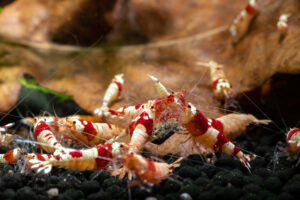
Recommended Commercial Foods: Offer high-quality shrimp pellets or granules specifically formulated for dwarf shrimp species. Look for products containing algae, spirulina, and other essential nutrients.
Supplemental Foods (Vegetables, Leaves, etc.): Supplemental food diet with blanched vegetables like spinach, zucchini, and carrots. Indian almond leaves or mulberry leaves can be added to provide beneficial tannins and a source of biofilm.
Feeding Frequency and Amount: Feed 2-3 times a week, an amount that the shrimp can consume within 1-2 hours. Avoid overfeeding to maintain water quality and prevent food from fouling the tank.
Understanding Fancy Tiger Shrimp Grading
Basic Principles of Fancy Tiger Shrimp Grading: Grading fancy tiger shrimp is based on the intensity and clarity of their coloration, the distinctness and symmetry of their stripes, and the overall appearance. Grades range from low to high based on these criteria. Grading plays a crucial role in breeding programs and determines the value of shrimp in the hobbyist market. High-grade shrimp are selectively bred to maintain and improve desirable traits over generations.
Color Grading
Description of Different Color Grades: Fancy tiger shrimp are graded based on the intensity and clarity of their colors. Grades typically range from lower to higher grades, such as:
- G3: These shrimp have lighter, less intense colors with more transparent areas on their bodies.
- G2: Mid-grade shrimp show more solid and consistent colors but may still have some lighter or transparent patches.
- G1: High-grade shrimp exhibit deep, vibrant colors with minimal transparency. The colors are solid and uniformly distributed.
- G0: Competition grade shrimp display the most intense and saturated colors with a flawless, uniform appearance, making them highly prized among breeders and collectors.
Several factors influence the color intensity of fancy tiger shrimp, including genetics, diet, water quality, and environmental conditions in the aquarium.
Breeding Fancy Tiger Shrimp
Breeding Setup Requirements: To encourage breeding, maintain stable water parameters with ample hiding places and a nutritious diet. Provide a well-established tank with plenty of live plants and mosses.
Mating Behavior: Fancy tiger shrimp typically mate through a process where the female releases pheromones to attract males. Mating occurs after a courtship dance, resulting in the female carrying eggs.

Egg Development and Hatching: Fertilized eggs are carried by the female under her tail, where they develop over a period of 3-4 weeks depending on temperature and water conditions. Once ready, the eggs hatch into miniature shrimplets.
Care for Shrimplets: Shrimplets are sensitive to water quality and require microscopic food sources like infusoria or specialized shrimp fry food. Ensure a well-maintained tank with stable parameters to support their growth and development.
Common Health Issues and Treatments
Signs of Stress or Illness: Watch for behaviors like lethargy, loss of appetite, unusual swimming patterns, or discoloration. Stress may result from poor water quality, sudden changes in parameters, or inadequate diet.
Common Diseases and Parasites: Fancy tiger shrimp are susceptible to diseases like bacterial infections (such as bacterial infections causing shell disease or cloudy patches), fungal infections (white fluffy growth), and parasitic infestations (like planaria or hydra).
Prevention and Treatment Options: Maintain excellent water quality and provide a balanced diet to prevent diseases. Quarantine new shrimp before introducing them to the main tank. Treatments may include medicated baths, antibiotic treatments, or specialized shrimp-safe medications. Consult with a veterinarian or experienced aquarist for proper diagnosis and treatment.
Compatible Tank Mates
Suitable Shrimp Species: Fancy tiger shrimp can generally be kept with other dwarf shrimp species like Crystal Red Shrimp, Crystal Black Shrimp, and other selectively bred Caridina and Neocaridina species.
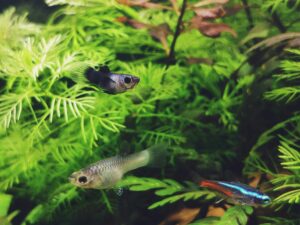
Compatible Fish Species: Choose small, peaceful fish species that won’t prey on shrimp. Some suitable options include small rasboras, tetras, endlers, and certain guppy strains. Avoid aggressive or predatory fish species. No fish are not recommended in a breeding colony.
Species to Avoid: Avoid keeping fancy tiger shrimp with large or aggressive fish, as well as species known to prey on shrimp, such as cichlids, larger barbs, and certain catfish species.
FAQs
Can Fancy Tiger Shrimp be Kept with Crystal Red Shrimp? Yes, fancy tiger shrimp and Crystal Red Shrimp (Caridina cantonensis) can generally be kept together as they share similar water parameter requirements and are compatible in terms of temperament.
Can Fancy Tiger Shrimp be Kept with Fish? Yes, provided the fish are small, non-aggressive, and won’t harm or prey on the shrimp. Always monitor interactions to ensure the shrimp are not stressed or harassed. No fish are not recommended in a breeding colony.
How Long Do Fancy Tiger Shrimp Live? Fancy tiger shrimp typically live for about 1.5 to 2 years in captivity, though proper care and optimal conditions can sometimes extend their lifespan.
How Often Do Fancy Tiger Shrimp Molt? Shrimp molt periodically throughout their lives to grow and regenerate. Fancy tiger shrimp molt approximately once every 4-6 weeks, depending on factors like temperature and diet.
What Causes Fancy Tiger Shrimp to Lose Color? Color loss in fancy tiger shrimp can be attributed to stress, poor water quality, inadequate diet, or genetic factors. Ensuring stable water parameters, a varied diet, and a stress-free environment can help maintain vibrant coloration.
Buying Guide
How to Spot Healthy Shrimp: Look for active and alert shrimp that are actively exploring their environment. Healthy shrimp should have clear, vibrant coloration without any signs of discoloration or unusual behavior.
Selecting the Best Specimens: Choose shrimp with intense and well-defined color patterns. Look for individuals that exhibit desirable traits such as clear markings, symmetrical patterns, and vibrant colors.
Reputable Sources for Purchasing Fancy Tiger Shrimp:
- Specialized Breeders: Look for breeders who specialize in Caridina shrimp and have positive reviews. Look for reputable lineages. Select reputable lineages carefully. To ensure consistent offspring and predictable gene inheritance when starting a breeding colony, use purebred or near purebred lineages, avoiding genes from other variants.
- Aquarium Shops: Reputable aquarium shops often have healthy shrimp but check their quarantine practices.
- Online Retailers: Choose online retailers with strong reputations and guarantees for live arrival and health.
Shipping Considerations: Ensure shrimp are shipped in insulated boxes with heat or cold packs depending on the weather. Opt for expedited shipping methods to minimize stress during transit. Acclimate shrimp slowly and carefully upon arrival to minimize shock.
Advanced Fancy Tiger Shrimp Keeping
Selective Breeding Techniques: To enhance and maintain desired traits, practice selective breeding by pairing shrimp with complementary genetics. Monitor offspring for desired color patterns and markings, selecting the best specimens for future breeding.
Creating Unique Color Morphs: Experiment with selective breeding to create new color morphs or patterns. Cross different color variants or selectively breed for specific traits to develop unique and distinctive shrimp varieties.
Participating in Shrimp Competitions: Engage in shrimp competitions to showcase your best specimens and compete with fellow hobbyists. These events provide opportunities to learn, exchange knowledge, and appreciate the diversity within the hobby.

